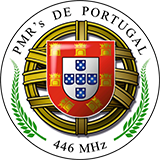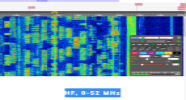Registe-se, faça a sua apresentação e terá acesso total ao TX&RX Fórum. ___________________________ Apresente-se dizendo quem é, escreva algo sobre si. Exemplo: Nome, indicativo, nome de estação, localidade, o que mais gosta de fazer no mundo das radio-comunicações e outras coisas que ache importante para a sua apresentação. Se é novato não tenha vergonha de o dizer, pois cá estamos para o ajudar.
___________________________ O TX&RX Fórum destina-se à publicações de mensagens "posts" relacionados com todos os assuntos sobre Radio Frequência. Essas mensagens têm como objectivo promover ideias, experiências, projectos, esclarecer duvidas, divulgação de actividades e publicações de novidades sobre Radio Comunicações.
Divirta-se!!
___________________________ O TX&RX Fórum destina-se à publicações de mensagens "posts" relacionados com todos os assuntos sobre Radio Frequência. Essas mensagens têm como objectivo promover ideias, experiências, projectos, esclarecer duvidas, divulgação de actividades e publicações de novidades sobre Radio Comunicações.
Divirta-se!!
Radio-burst discovery deepens astrophysics mystery – Arecibo
TX RX Fórum :: TX&RX Jornal :: Espaço
Página 1 de 1
 Radio-burst discovery deepens astrophysics mystery – Arecibo
Radio-burst discovery deepens astrophysics mystery – Arecibo
[Tens de ter uma conta e sessão iniciada para poderes visualizar esta imagem]
The discovery of a split-second burst of radio waves by scientists using the Arecibo radio telescope in Puerto Rico provides important new evidence of mysterious pulses that appear to come from deep in outer space.
The finding by an international team of astronomers, published July 10 in The Astrophysical Journal, marks the first time that a so-called “fast radio burst” has been detected using an instrument other than the Parkes radio telescope in Australia. Scientists using the Parkes Observatory have recorded a handful of such events, but the lack of any similar findings by other facilities had led to speculation that the Australian instrument might have been picking up signals originating from sources on or near Earth.
“Our result is important because it eliminates any doubt that these radio bursts are truly of cosmic origin,” said Victoria Kaspi, an astrophysics professor at McGill University in Montreal and Principal Investigator for the pulsar-survey project that detected this fast radio burst. “The radio waves show every sign of having come from far outside our galaxy – a really exciting prospect.”
Exactly what may be causing such radio bursts represents a major new enigma for astrophysicists. Possibilities include a range of exotic astrophysical objects, such as evaporating black holes, mergers of neutron stars, or flares from magnetars — a type of neutron star with extremely powerful magnetic fields.
“Another possibility is that they are bursts much brighter than the giant pulses seen from some pulsars,” notes James Cordes, a professor of astronomy at Cornell University and co-author of the new study.
The unusual pulse was detected on Nov. 2, 2012, at the Arecibo Observatory, a National Science Foundation-sponsored facility that boasts the world’s largest and most sensitive radio telescope, with a radio-mirror dish spanning 305 metres and covering about 20 acres.
While fast radio bursts last just a few thousandths of a second and have rarely been detected, the international team of scientists reporting the Arecibo finding confirm previous estimates that these strange cosmic bursts occur roughly 10,000 times a day over the whole sky. This astonishingly large number is inferred by calculating how much sky was observed, and for how long, in order to make the few detections that have so far been reported.
“The brightness and duration of this event, and the inferred rate at which these bursts occur, are all consistent with the properties of the bursts previously detected by the Parkes telescope in Australia,” said Laura Spitler, lead author of the new paper. Dr. Spitler, now a postdoctoral researcher at the Max Planck Institute for Radio Astronomy in Bonn, Germany, was a PhD student at Cornell when the research work began.
The bursts appear to be coming from beyond the Milky Way galaxy based on measurement of an effect known as plasma dispersion. Pulses that travel through the cosmos are distinguished from man-made interference by the effect of interstellar electrons, which cause radio waves to travel more slowly at lower radio frequencies. The burst detected by the Arecibo telescope has three times the maximum dispersion measure that would be expected from a source within the galaxy, the scientists report.
[Tens de ter uma conta e sessão iniciada para poderes visualizar esta imagem]
The discovery was made as part of the Pulsar Arecibo L-Band Feed Array (PALFA) survey, which aims to find a large sample of pulsars and to discover rare objects useful for probing fundamental aspects of neutron star physics and testing theories of gravitational physics.
Efforts are now under way to detect radio bursts using radio telescopes that can observe broad swaths of the sky to help identify them. Telescopes under construction in Australia and South Africa as well as the CHIME telescope in Canada have the potential to detect fast radio bursts; astronomers say these and other new facilities could pave the way for many more discoveries and a better understanding of this mysterious cosmic phenomenon.
[Tens de ter uma conta e sessão iniciada para poderes visualizar esta imagem]
The research was supported by grants from the European Research Council, the National Science Foundation, the Natural Sciences and Engineering Research Council of Canada, the Fonds de recherche du Québec – Nature et technologies, and the Canadian Institute for Advanced Research, among others. Prof. Kaspi is the R. Howard Webster Foundation Fellow of CIFAR’s Cosmology & Gravity program; she also holds the Lorne Trottier Chair in Astrophysics and Cosmology as well as a Canada Research Chair at McGill.
The Arecibo Observatory is operated by SRI International in alliance with Ana G. Méndez-Universidad Metropolitana and the Universities Space Research Association, under a cooperative agreement with the National Science Foundation (AST-1100968). The data were processed on the ATLAS cluster of the Max Planck Institute for Gravitational Physics (Albert Einstein Institute), Hannover, Germany.
____________________________________________
Fast Radio Burst Discovered in the Arecibo Pulsar ALFA Survey,” by L.G. Spitler, J.M. Cordes, et al. The Astrophysical Journal. Published online July 10, 2014. [Tens de ter uma conta e sessão iniciada para poderes visualizar este link]
IMAGES:
- Optical sky image of the area in the constellation Auriga where the fast radio burst FRB 121102 has been detected. The position of the burst, between the old supernova remnant S147 (left) and the star formation region IC 410 (right) is marked with a green circle. The burst appears to originate from much deeper in space, far beyond our galaxy. CREDIT: Rogelio Bernal Andreo (DeepSkyColors.com).
- The Arecibo Observatory. CREDIT: NAIC – Arecibo Observatory, a facility of the NSF
Arecibo
[Tens de ter uma conta e sessão iniciada para poderes visualizar esta imagem]
- Fonte
The discovery of a split-second burst of radio waves by scientists using the Arecibo radio telescope in Puerto Rico provides important new evidence of mysterious pulses that appear to come from deep in outer space.
The finding by an international team of astronomers, published July 10 in The Astrophysical Journal, marks the first time that a so-called “fast radio burst” has been detected using an instrument other than the Parkes radio telescope in Australia. Scientists using the Parkes Observatory have recorded a handful of such events, but the lack of any similar findings by other facilities had led to speculation that the Australian instrument might have been picking up signals originating from sources on or near Earth.
“Our result is important because it eliminates any doubt that these radio bursts are truly of cosmic origin,” said Victoria Kaspi, an astrophysics professor at McGill University in Montreal and Principal Investigator for the pulsar-survey project that detected this fast radio burst. “The radio waves show every sign of having come from far outside our galaxy – a really exciting prospect.”
Exactly what may be causing such radio bursts represents a major new enigma for astrophysicists. Possibilities include a range of exotic astrophysical objects, such as evaporating black holes, mergers of neutron stars, or flares from magnetars — a type of neutron star with extremely powerful magnetic fields.
“Another possibility is that they are bursts much brighter than the giant pulses seen from some pulsars,” notes James Cordes, a professor of astronomy at Cornell University and co-author of the new study.
The unusual pulse was detected on Nov. 2, 2012, at the Arecibo Observatory, a National Science Foundation-sponsored facility that boasts the world’s largest and most sensitive radio telescope, with a radio-mirror dish spanning 305 metres and covering about 20 acres.
While fast radio bursts last just a few thousandths of a second and have rarely been detected, the international team of scientists reporting the Arecibo finding confirm previous estimates that these strange cosmic bursts occur roughly 10,000 times a day over the whole sky. This astonishingly large number is inferred by calculating how much sky was observed, and for how long, in order to make the few detections that have so far been reported.
“The brightness and duration of this event, and the inferred rate at which these bursts occur, are all consistent with the properties of the bursts previously detected by the Parkes telescope in Australia,” said Laura Spitler, lead author of the new paper. Dr. Spitler, now a postdoctoral researcher at the Max Planck Institute for Radio Astronomy in Bonn, Germany, was a PhD student at Cornell when the research work began.
The bursts appear to be coming from beyond the Milky Way galaxy based on measurement of an effect known as plasma dispersion. Pulses that travel through the cosmos are distinguished from man-made interference by the effect of interstellar electrons, which cause radio waves to travel more slowly at lower radio frequencies. The burst detected by the Arecibo telescope has three times the maximum dispersion measure that would be expected from a source within the galaxy, the scientists report.
[Tens de ter uma conta e sessão iniciada para poderes visualizar esta imagem]
The discovery was made as part of the Pulsar Arecibo L-Band Feed Array (PALFA) survey, which aims to find a large sample of pulsars and to discover rare objects useful for probing fundamental aspects of neutron star physics and testing theories of gravitational physics.
Efforts are now under way to detect radio bursts using radio telescopes that can observe broad swaths of the sky to help identify them. Telescopes under construction in Australia and South Africa as well as the CHIME telescope in Canada have the potential to detect fast radio bursts; astronomers say these and other new facilities could pave the way for many more discoveries and a better understanding of this mysterious cosmic phenomenon.
[Tens de ter uma conta e sessão iniciada para poderes visualizar esta imagem]
The research was supported by grants from the European Research Council, the National Science Foundation, the Natural Sciences and Engineering Research Council of Canada, the Fonds de recherche du Québec – Nature et technologies, and the Canadian Institute for Advanced Research, among others. Prof. Kaspi is the R. Howard Webster Foundation Fellow of CIFAR’s Cosmology & Gravity program; she also holds the Lorne Trottier Chair in Astrophysics and Cosmology as well as a Canada Research Chair at McGill.
The Arecibo Observatory is operated by SRI International in alliance with Ana G. Méndez-Universidad Metropolitana and the Universities Space Research Association, under a cooperative agreement with the National Science Foundation (AST-1100968). The data were processed on the ATLAS cluster of the Max Planck Institute for Gravitational Physics (Albert Einstein Institute), Hannover, Germany.
____________________________________________
Fast Radio Burst Discovered in the Arecibo Pulsar ALFA Survey,” by L.G. Spitler, J.M. Cordes, et al. The Astrophysical Journal. Published online July 10, 2014. [Tens de ter uma conta e sessão iniciada para poderes visualizar este link]
IMAGES:
- Optical sky image of the area in the constellation Auriga where the fast radio burst FRB 121102 has been detected. The position of the burst, between the old supernova remnant S147 (left) and the star formation region IC 410 (right) is marked with a green circle. The burst appears to originate from much deeper in space, far beyond our galaxy. CREDIT: Rogelio Bernal Andreo (DeepSkyColors.com).
- The Arecibo Observatory. CREDIT: NAIC – Arecibo Observatory, a facility of the NSF
Arecibo
[Tens de ter uma conta e sessão iniciada para poderes visualizar esta imagem]
- Fonte

ALF007- Administrador Fundador
 Tópicos semelhantes
Tópicos semelhantes» Radio-telescópio Arecibo
» An Insider's Tour of the Arecibo Observatory
» VEJA A CABINE DE COMANDO ÔNIBUS ESPACIAL DISCOVERY
» RÁDIO VATICANO Radio Visite o Centro de Santa Maria di Galeria
» Rádio amador e Linux - evite que seu rádio se torne automaticamente o dispositivo de áudio padrão.
» An Insider's Tour of the Arecibo Observatory
» VEJA A CABINE DE COMANDO ÔNIBUS ESPACIAL DISCOVERY
» RÁDIO VATICANO Radio Visite o Centro de Santa Maria di Galeria
» Rádio amador e Linux - evite que seu rádio se torne automaticamente o dispositivo de áudio padrão.
TX RX Fórum :: TX&RX Jornal :: Espaço
Página 1 de 1
Permissões neste sub-fórum
Não podes responder a tópicos












 por
por 





